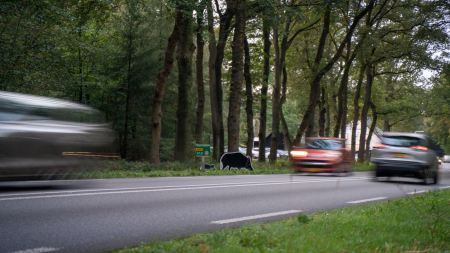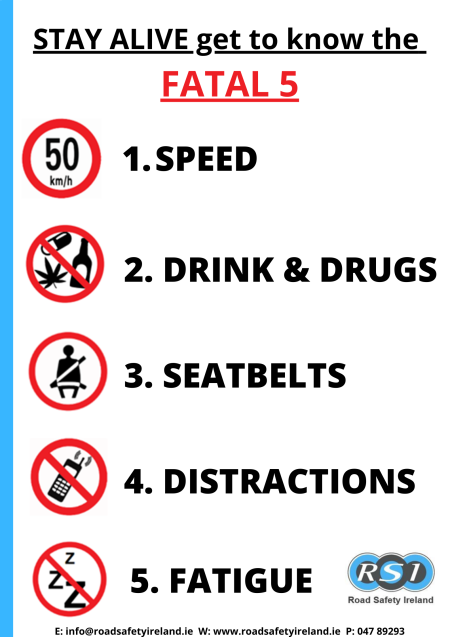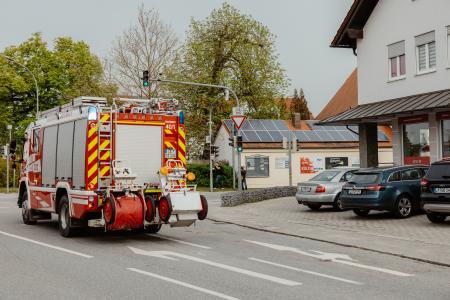Car drivers

Monday, June 17, 2024
Nature in Gelderland is thriving, with a growing number of wild animals. This is a beautiful phenomenon, but unfortunately, it also brings an increased risk of accidents involving wild animals. The chances of a poor outcome for the animal are high, but there is also a significant risk of material damage and severe consequences for the driver. The risk of collisions with wildlife is especially higher during certain periods, specific times, and at certain locations. Think of dawn and dusk, and the transition to winter or summer time.
In the past, the Province of Gelderland has taken various measures by adjusting the infrastructure and influencing the behavior of wild animals. Examples of these measures include the installation of warning signs, wildlife grids, and boar disappearance blocks. However, it turns out that more is needed to tackle the problem.
Drivers often underestimate the risk of animals being along the roads in the forests. Despite the recommended speed limits, they often drive too fast and are not always aware of the risk of animals along the roads. Therefore, the province of Gelderland wants to place more emphasis on the behavior of road users. In response to this need, creative behavioral agency andc and behavioral agency Dijksterhuis and Van Baaren have developed a behavior-oriented approach, including interventions, to encourage road users to adhere to the recommended speed limits.
In the past, the Province of Gelderland has taken various measures by adjusting the infrastructure and influencing the behavior of wild animals. Examples of these measures include the installation of warning signs, wildlife grids, and boar disappearance blocks. However, it turns out that more is needed to tackle the problem.
Drivers often underestimate the risk of animals being along the roads in the forests. Despite the recommended speed limits, they often drive too fast and are not always aware of the risk of animals along the roads. Therefore, the province of Gelderland wants to place more emphasis on the behavior of road users. In response to this need, creative behavioral agency andc and behavioral agency Dijksterhuis and Van Baaren have developed a behavior-oriented approach, including interventions, to encourage road users to adhere to the recommended speed limits.
Monday, June 17, 2024
The safety inspections conducted over time on incident-prone areas and the analyses carried out on accident cases through the SISS (Incident Information and Analysis System) present at the Road Safety Competence Center of Rome Capital have allowed for the identification of multiple concurrent elements that can lead to accidents, such as (indicative and non-exhaustive list):
Excessive speed relative to the road's horizontal and vertical characteristics and its context;
Driver distraction due to the use of electronic devices;
Failure to comply with road traffic rules and regulations;
Failure to comply with visibility triangle requirements or minimum safe stopping distances;
Failure to use pedestrian crossings;
Failure to obey traffic signals, either due to a lack of feedback from the signaling system (pedestrian call buttons) or excessively long signal times;
Pedestrian crossings in areas with limited visibility;
Overlap of conflicting functions in the same spaces;
Scooters or bicycles being ridden in pedestrian areas or on sidewalks;
Illegal parking at intersections, on pedestrian crossings, near waste containers, or double parking;
Excessive speed relative to the road's horizontal and vertical characteristics and its context;
Driver distraction due to the use of electronic devices;
Failure to comply with road traffic rules and regulations;
Failure to comply with visibility triangle requirements or minimum safe stopping distances;
Failure to use pedestrian crossings;
Failure to obey traffic signals, either due to a lack of feedback from the signaling system (pedestrian call buttons) or excessively long signal times;
Pedestrian crossings in areas with limited visibility;
Overlap of conflicting functions in the same spaces;
Scooters or bicycles being ridden in pedestrian areas or on sidewalks;
Illegal parking at intersections, on pedestrian crossings, near waste containers, or double parking;

Sunday, June 16, 2024
The key objective is to improve the safety of learner drivers and provide a safe driving environment in which learners can practice safe driving skills. In primary research undertaken in 2018, 31% of Advanced Driving Instructors (ADIs) surveyed agreed that the Essential Driver Training programme (EDT) in Ireland did not provide a safe driving environment for learner drivers. Although it is illegal, driving unaccompanied is regularly done by a large percentage of learner drivers. As part of Phase 1 of the Road Safety Strategy (RSS) 2021-2024 a goal has been set to eliminate unaccompanied driving in Ireland by Q4 2024. The Behaviours and Attitudes Survey (2019) found 39% of learner drivers drive unaccompanied. In 2022, 5,929 learner drivers received penalty points for driving unaccompanied.
Ireland has a population of 5.5 million people, on average per year we have 11 fatalities and 45 serious injuries from road collisions with drivers pre-test (2007-2021 data). 80% of fatal collisions involved learner drivers who were driving unsupervised, while 75% of serious injury collisions involved unsupervised learner drivers. We know from research undertaken that collisions involving learner drivers reduce by 80% whilst accompanied. No one should die while learning to drive.
Ireland has a population of 5.5 million people, on average per year we have 11 fatalities and 45 serious injuries from road collisions with drivers pre-test (2007-2021 data). 80% of fatal collisions involved learner drivers who were driving unsupervised, while 75% of serious injury collisions involved unsupervised learner drivers. We know from research undertaken that collisions involving learner drivers reduce by 80% whilst accompanied. No one should die while learning to drive.

Sunday, June 16, 2024
From the first of September 2022, MKIF Magyar Koncessziós Infrastruktursa Fejlsztó Zrt took over the operation, maintenance and development of 1,237 km of existing Hungarian expressways.
When analyzing the accidents recorded by our traffic surveillance cameras on domestic expressways, we noticed that it is important to draw attention to traffic safety in our communication (keeping a following distance, observing the speed limit near work areas, protecting our colleagues, early education of children/young adults in safe traffic) and traffic -culture (littering, driving in an egoistic style that endangers others, early education of children/young adults on responsible driving).
When analyzing the accidents recorded by our traffic surveillance cameras on domestic expressways, we noticed that it is important to draw attention to traffic safety in our communication (keeping a following distance, observing the speed limit near work areas, protecting our colleagues, early education of children/young adults in safe traffic) and traffic -culture (littering, driving in an egoistic style that endangers others, early education of children/young adults on responsible driving).

Sunday, June 16, 2024
Main challanges are to provide Self-Explaining road design around Schools and School areas and where Children walk to School. therefore drivers tend to slow down and become more attentive in traffic, also maximun speeds (Vmax) are much lower.
Consequently Children are more safe going to School and around School areas, drivers drives more safe and with that walkability and using of sustainable transport (public, bikes...) increased.
Consequently Children are more safe going to School and around School areas, drivers drives more safe and with that walkability and using of sustainable transport (public, bikes...) increased.

Saturday, June 15, 2024
The main road safety challenge that was tackled in this initiative is safety of the pedestrians and drivers on the main street of Põlva. The daily traffic volume on this road segment is high, with approximately 5000 vehicles, including trucks, passing through it every day. Simultaneously, high number of pedestrians use the same road daily to get to work or school. From a traffic safety perspective, this road segment is challenging – the hilly and winding road can distract drivers from speed limits, and the increased prevalence of light vehicles (bicycles, scooters etc) further amplifies the danger of this situation.
Smart Road is a vision of the future street, where all road users are equally preferred, and the emphasis is no longer solely on cars. Smart Road is designed to encourage drivers to objectively consider their traffic behaviour and to pay more attention to vulnerable road users. At the same time, the creators of Smart Road understand that vulnerable road users are indeed more difficult to notice, and effective solutions must be provided to assist drivers in focusing their attention on them.
Smart Road is a vision of the future street, where all road users are equally preferred, and the emphasis is no longer solely on cars. Smart Road is designed to encourage drivers to objectively consider their traffic behaviour and to pay more attention to vulnerable road users. At the same time, the creators of Smart Road understand that vulnerable road users are indeed more difficult to notice, and effective solutions must be provided to assist drivers in focusing their attention on them.

Friday, June 14, 2024
Drivers encounter dangerous situations on the roads daily, arising from aggressive driving behavior. The project DriveArse (Czech: Nenechte se rozladit - Řitiči) indirectly built upon findings from the project Aggression Kills (Agresivita zabíjí by ČAP, BESIP) and systematically used them to create a positive solution in situations where a road user is confronted with aggression behind the wheel.
Previous research (Aggression Kills, ČAP, BESIP) indicate that aggressive driving causes up to 40% of fatal traffic accidents. Aggressive driving is dangerous not only for the drivers themselves but also for those around them. 7 out of 10 drivers admit that they are provoked into aggressive driving and change their own driving style. This is linked to the belief of 88% of Czech drivers in the increasing aggression behind the wheel. Almost 60% of drivers under 30 sometimes intentionally do not maintain a safe distance from the vehicle in front of them, and 20% of them purposely speed up when another car is trying to overtake them. At the same time, 87% of drivers are motivated by the considerate driving of others.
In the case of aggression behind the wheel, the current legislative support in the Czech Republic is rather general and does not contain precise definitions of aggressive behavior behind the wheel, its specific manifestations, or the exact penalties that may be imposed. The DriveArse campaign was therefore carried out together with the efforts of Platforma VIZE 0 for legislative changes, using experiences from selected EU countries where legislation defines what precisely aggression is and imposes specific sanctions.
This project comes up with a positive attitude and wit as a tool to deal with unpleasant situations on the road, while also functioning as a creative research. It presents manifestations of aggression through caricatures of aggressive drivers with creative names. In this way, it helps road users to recognise and name aggressive drivers, as well as not to be provoked by such aggressive drivers and to handle the situation with humour (for example with a rhyme or a funny remark).
Previous research (Aggression Kills, ČAP, BESIP) indicate that aggressive driving causes up to 40% of fatal traffic accidents. Aggressive driving is dangerous not only for the drivers themselves but also for those around them. 7 out of 10 drivers admit that they are provoked into aggressive driving and change their own driving style. This is linked to the belief of 88% of Czech drivers in the increasing aggression behind the wheel. Almost 60% of drivers under 30 sometimes intentionally do not maintain a safe distance from the vehicle in front of them, and 20% of them purposely speed up when another car is trying to overtake them. At the same time, 87% of drivers are motivated by the considerate driving of others.
In the case of aggression behind the wheel, the current legislative support in the Czech Republic is rather general and does not contain precise definitions of aggressive behavior behind the wheel, its specific manifestations, or the exact penalties that may be imposed. The DriveArse campaign was therefore carried out together with the efforts of Platforma VIZE 0 for legislative changes, using experiences from selected EU countries where legislation defines what precisely aggression is and imposes specific sanctions.
This project comes up with a positive attitude and wit as a tool to deal with unpleasant situations on the road, while also functioning as a creative research. It presents manifestations of aggression through caricatures of aggressive drivers with creative names. In this way, it helps road users to recognise and name aggressive drivers, as well as not to be provoked by such aggressive drivers and to handle the situation with humour (for example with a rhyme or a funny remark).

Friday, June 14, 2024
We are focusing on the most common causation factors of accidents/collsions on roads.

Friday, June 14, 2024
El desafío es implementar una iniciativa que permite mejorar y poner en práctica acciones que reduzcan los enclaves de concentración de accidentes, recogiendo el propósito de “Avanzar juntos hacia una movilidad segura”, compartiendo y comprometiéndonos a conseguir unos objetivos, desarrollando unas actividades que permite abordar con éxito el problema de la seguridad vial urbana en la Ciudad de Madrid, la segunda Ciudad Europea con mayor población.

Friday, June 14, 2024
Vulnerable road users (VRUs), including pedestrians and cyclists face several significant road safety challenges, especially at the intersections and crosswalks. Poorly designed or marked crosswalks, inappropriate traffic light planning and lack of pedestrian priority measures contribute to higher risks. More particularly, many intersections do not give sufficient priority to pedestrian or cyclists. Short crossing times, lack of adequate pedestrian requests, lack of dedicated pedestrian phases, lack of information providing to the VRUs, and insufficient waiting areas at intersections increase the risk of accidents and put in jeopardy the safe crossing of the intersection. Examining the accidents in intersections has revealed that one of the situations with high accident risk is when a vehicle is performing a right turn at the intersection while a cyclist or pedestrian is crossing the road straight and is at the blind spot of the driver.
Furthermore, the approaching and crossing of an intersection by an emergency vehicle using only the alarm is a critical safety situation for different groups of road users. Firstly, emergency vehicles are facing critical and dangerous situations while getting to the emergency scene time, since drivers do not react immediately to make space and in front of red traffic lights, many drivers wait for "green" instead of carefully crossing the stop line and making room for it. In addition, the vulnerable road users could also be exposed to danger in this scenario. For example, a pedestrian may not be paying attention and hear the alarm too late or it could be a hearing impaired person.
Furthermore, the approaching and crossing of an intersection by an emergency vehicle using only the alarm is a critical safety situation for different groups of road users. Firstly, emergency vehicles are facing critical and dangerous situations while getting to the emergency scene time, since drivers do not react immediately to make space and in front of red traffic lights, many drivers wait for "green" instead of carefully crossing the stop line and making room for it. In addition, the vulnerable road users could also be exposed to danger in this scenario. For example, a pedestrian may not be paying attention and hear the alarm too late or it could be a hearing impaired person.